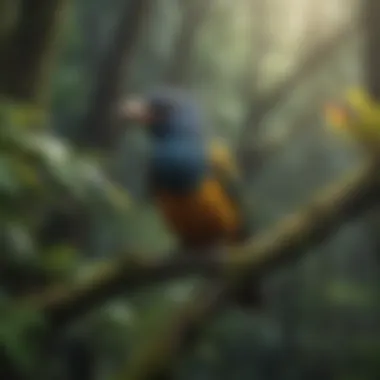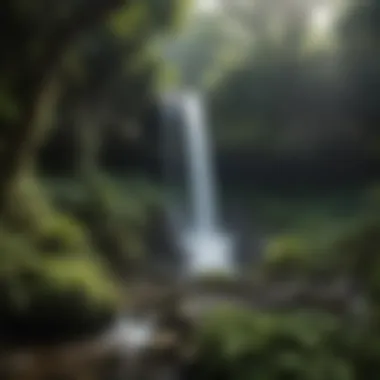Exploring El Yunque Rainforest: A Complete Guide


Intro
El Yunque National Rainforest serves as a pivotal ecological asset in Puerto Rico. It is not just a scenic spot but an intricate web of life, showcasing diverse flora and fauna that must be understood. This rainforest plays a critical role in both the natural and cultural landscape of the island. As we navigate through this guide, we will explore various aspects of this unique ecosystem, emphasizing the importance of responsible tourism and the need for sustainable practices.
Understanding Woodland Ecosystems
Importance of Biodiversity in Forests
Biodiversity stands as the foundation of healthy woodland ecosystems. In El Yunque, this biodiversity includes myriad species of trees, plants, and animals, each contributing to the ecological balance. The rainforest provides habitat for over 240 species of trees, many of which are endemic. Such diversity enhances resilience against environmental changes, ensuring the survival of various species, including the endangered Puerto Rican parrot, a true symbol of conservation efforts.
Role of Forests in Climate Regulation
Forests, particularly tropical rainforests like El Yunque, play a substantial role in regulating the climate. Through a process known as transpiration, trees release water vapor into the atmosphere, influencing rainfall patterns. Furthermore, the dense canopy of El Yunque acts as a buffer, absorbing carbon dioxide and mitigating greenhouse gas effects. Preserving this rainforest is crucial not only for local climate but also for global ecological stability.
"The preservation of El Yunque National Rainforest is a commitment to maintaining ecological balance and cultural heritage."
Sustainable Forestry Practices
Principles of Sustainable Forestry
Sustainable forestry focuses on maintaining forest health while fulfilling economic needs. Ethical practices include selective logging, respecting old-growth trees, and ensuring replanting efforts. In El Yunque, sustainable tourism aligns with these principles, promoting low-impact activities that support conservation. Visitors can partake in activities that encourage the appreciation of nature while ensuring minimal disturbance to the ecosystem.
Case Studies of Successful Implementations
Analyzing successful case studies is vital for understanding sustainable practices in action. For instance, the establishment of protected areas within El Yunque has shown significant results. This initiative limits exploitation and promotes ecological research. Similar approaches in other rainforests across the world, such as Canada’s Great Bear Rainforest, highlight how combining conservation with community involvement results in positive outcomes.
Woodland Stewardship Techniques
Forest Management Plans
Effective forest management plans can dictate how resources are used and protected. In El Yunque, these plans are designed to ensure a harmonious balance between human activity and ecological integrity. Such plans typically outline strategies for habitat restoration, visitor management, and monitoring species health. Collaboration with local communities is often a feature of these frameworks, ensuring that their knowledge and needs are incorporated.
Conservation Strategies
Conservation strategies employed in El Yunque include habitat restoration, reforestation efforts, and creating wildlife corridors. These practices aim to enhance the resilience of the ecosystem against threats like climate change and invasive species. Efforts by organizations and local governments contribute to creating awareness and funds necessary for ongoing conservation initiatives.
In summary, El Yunque National Rainforest is not just a site to visit; it is an ecosystem that requires understanding, respect, and careful management. With guided information, visitors can appreciate its beauty while contributing to its preservation.
Preamble to El Yunque National Rainforest
El Yunque National Rainforest stands as a unique ecosystem within Puerto Rico, serving not only as a rich habitat for diverse species but also as a vital resource for the island's cultural and environmental identity. This article seeks to offer a comprehensive exploration of this important site, delving into various aspects from biodiversity to sustainable tourism practices. By understanding El Yunque’s features and significance, readers can appreciate its role in conservation and cultural heritage.
Historical Context
El Yunque has a rich, layered history that dates back centuries. The indigenous Taíno people revered the rainforest, considering it sacred. They named it "Yuquiyu", which translates to "the place of the gods". This cultural significance has persisted, influencing local traditions and folklore. During the Spanish colonization, this environment faced various changes as settlers exploited resources. Today, El Yunque is the only tropical rainforest in the United States National Forest System, established as a reserve in 1903. Its designation underscores the importance of protecting this unique habitat for future generations and preserving its cultural legacy.
Geographical Overview
Covering approximately 28,000 acres, El Yunque showcases a diverse topography ranging from lush valleys to steep mountains. The highest peak, El Yunque Peak, rises to about 3,494 feet. Various climate zones, driven by elevation and proximity to the ocean, create microhabitats that sustain an impressive array of biodiversity. The average rainfall exceeds 200 inches annually, making it one of the wettest spots in the U.S.
The combination of rich soils, high humidity, and ample sunlight supports evergreen forests rich in ferns, hardwoods, and orchids. Such geographical attributes make El Yunque not only a paradise for outdoor enthusiasts but also a vital center for scientific research, focusing on unique ecological processes and adaptation strategies among its flora and fauna.
Biodiversity Within El Yunque
Biodiversity in El Yunque National Rainforest is crucial to maintaining the ecological balance and showcasing the unique characteristics of this rich habitat. The rainforest is home to varied species of plants and animals. Its preservation is not only important for the ecosystem but also for research and educational purposes. Biodiversity contributes benefits such as soil stabilization, water purification, and climate regulation.
Flora of El Yunque
Native Species
Native plant species are essential to the rainforest's ecosystem. They provide food and habitat for numerous animals and contribute to the aesthetic beauty of El Yunque. For instance, the Tabebuia heterophylla, known as the white cedar, grows tall and exhibits beautiful blooms. This tree plays a significant role in supporting local wildlife. The advantages of native species include their adaptations to the local climate and soil types, making them resilient and sustainable choices for cultivation. However, they may be threatened by invasive species, which can disrupt the ecological balance.
Endangered Plants


Endangered plants represent a pressing concern within El Yunque. One example is the Pseudophoenix sargentii, commonly known as the Sargent's cherry palm, which is nearly extinct. These plants are important for biodiversity conservation, as they may serve unique functions in their ecosystem. Highlighting their plight raises awareness about conservation needs. The unique feature of endangered plants is their limited distribution and specialized habitat requirements. This makes protecting them vital for maintaining ecological integrity.
Medicinal Plants
Medicinal plants found in El Yunque also hold significant value. Plants like Piper methysticum, known for its traditional medicinal properties, contribute to the health and well-being of local communities. These plants serve as critical resources for medicine and health. Highlighting their use supports local practices and preserves cultural heritage. The unique aspect of medicinal plants is their potential for discovery by modern science. However, over-harvesting can threaten these valuable resources.
Fauna of El Yunque
Bird Species
The bird species of El Yunque include several endemic and migratory types. The Puerto Rican parrot, or Amazona vittata, is one of the most notable. This bird's population has drastically declined, making its protection a priority. Bird species contribute to seed dispersal, which supports plant regeneration. The unique feature of these birds is their role in maintaining the rainforest's biodiversity. However, habitat loss poses serious risks to their survival.
Mammals and Reptiles
Mammals and reptiles in El Yunque also play significant roles in the ecosystem. The Megalomys desmarestii, a small rodent, exemplifies the unique fauna of the rainforest. These mammals aid in seed dispersal and contribute to nutrient cycling. The highlight of reptiles, such as the endangered Eleutherodactylus coqui, is their ecological importance. Each species faces threats from habitat destruction, necessitating focused conservation efforts.
Insect Diversity
Insect diversity in El Yunque is extensive and supports various ecological functions. Pollinators, such as bees and butterflies, are essential for plant reproduction. Their presence indicates the health of the rainforest. The unique feature of this diversity is its role in food webs and ecosystem services. However, climate change poses challenges to insect populations, which could affect the entire ecosystem.
It is vital to understand the biodiversity within El Yunque. Each species is interconnected, contributing to the overall health of the rainforest.
This examination of biodiversity within El Yunque not only enriches the knowledge of ecosystems but also aids in fostering a deeper connection to the natural world. Understanding these complex interactions allows for better conservation efforts and promotes sustainable practices.
The Importance of Conservation
Conservation is a fundamental aspect of maintaining the ecological health of El Yunque National Rainforest. This rainforest, which is one of the most biodiverse destinations globally, faces various threats. Human activity, invasive species, and climate change further complicate its preservation. Therefore, understanding conservation allows for better protection of unique species and habitats present in this region. The benefits of conservation extend beyond preserving nature; they also affect local communities economically and culturally. Thus, it serves as a platform for promoting a sustainable relationship between the environment and human beings.
Conservation Strategies
Habitat Restoration
Habitat restoration focuses on returning degraded ecosystems to their original state. In El Yunque, this involves reforestation and rehabilitation of the landscape. The strategy is significant because it helps restore natural processes, supports biodiversity, and improves ecosystem services, like water purification. The unique feature of habitat restoration is that it often incorporates the participation of local communities, fostering a sense of ownership and responsibility. However, challenges include limited funding and the need for ongoing maintenance.
Species Protection Programs
Species protection programs are essential for safeguarding endangered species within El Yunque. These programs aim to monitor and manage habitats for vulnerable species. A key characteristic of these programs is their focus on specific species that are at risk, such as the Puerto Rican Parrot. They are beneficial because they contribute to genetic diversity and ecosystem stability. The unique feature is their approach to involve community engagement through educational outreach. Nonetheless, challenges include the necessity for constant funding and the potential for habitat loss due to external pressures.
Research Initiatives
Research initiatives in El Yunque contribute to a greater understanding of its ecosystem dynamics. These initiatives promote scientific studies that aid in species monitoring and climate adaptation strategies. A defining characteristic of research initiatives is their collaborative nature, often involving universities and environmental organizations. This approach is beneficial as it expands knowledge and guides conservation policies. However, the disadvantage includes potential gaps in data, requiring adaptive management techniques to ensure relevance.
Impact of Climate Change
Current Threats
Climate change presents several current threats to the biodiversity of El Yunque. These threats include rising temperatures, altered precipitation patterns, and increased frequency of extreme weather events. The key characteristic of current threats lies in their ability to impact both flora and fauna, leading to habitat degradation and species extinction. Addressing these issues is essential because they not only threaten the rainforest but also the interconnected ecosystems surrounding it. Challenges include monitoring changing conditions and developing immediate responsive strategies.
Adaptation Measures
Adaptation measures are strategies employed to mitigate the effects of climate change on El Yunque. These measures include implementing sustainable land practices and enhancing natural barriers against erosion. A key characteristic of these measures is their proactive nature, aiming to minimize future damage. They are beneficial since they not only protect the rainforest but also offer solutions for local communities facing the impacts of climate change. However, the implementation often depends on collective action and necessary support from both local and global stakeholders.
Long-term Projections
Long-term projections examine the future impacts of climate change on El Yunque. Such projections assess how changing climatic conditions may alter species distribution and ecosystem services. The significance of long-term projections lies in their ability to inform decision-making processes for conservation strategies. One unique feature is how they guide the allocation of resources for monitoring and management. Nevertheless, uncertainties in climate models can pose challenges, requiring ongoing adjustments in conservation planning.
Effective conservation in El Yunque hinges on recognizing the nuanced interplay between humans and the environment. Sustainable practices not only preserve this unique ecosystem but foster community resilience.
Touring El Yunque National Rainforest
Touring El Yunque National Rainforest is an essential part of understanding this unique ecosystem. The rainforest attracts thousands of visitors every year, enhancing awareness and appreciation of its rich biodiversity. Each visit contributes to low-impact tourism, stimulating local economies while educating the public on conservation efforts. Given the sensitivity of the ecosystem, careful planning can ensure that a visit is both enjoyable and responsible.
Preparing for Your Visit
When preparing for your visit, knowledge about the rainforest's climate and accessibility is vital. One must anticipate both the grandeur and the challenges posed by a tropical rainforest.


Best Times to Visit
The best times to visit El Yunque National Rainforest are during the cooler and drier months, typically from December to April. This seasonal window offers pleasant weather, reducing the likelihood of rain. Visiting during this period allows for better visibility of the numerous scenic viewpoints and waterfalls. However, visitors should be aware that this is also the peak tourist season, which means more crowds. Choosing to visit during weekdays can mitigate this issue, allowing for a more tranquil experience.
What to Bring
Bringing appropriate gear is crucial for any visit to the rainforest. Visitors should pack sturdy, waterproof footwear and clothing suitable for humid conditions. Additionally, it is wise to carry insect repellent, sunscreen, and a reusable water bottle. Having a first-aid kit is also recommended, as the varied terrain may pose risks. Preparing in advance contributes to a safer and more comfortable exploration.
Safety Guidelines
Safety guidelines are important to follow while exploring El Yunque. Staying on marked trails helps protect native flora and fauna. It is essential to observe wildlife from a distance, ensuring that natural habits are not disturbed. Weather conditions can change rapidly, so visitors should remain vigilant about forecasts. Bringing a map or using a GPS device can help avoid getting lost in the dense forest. Overall, adhering to these guidelines ensures a safer experience.
Available Tour Options
Exploring El Yunque can be done through various tour options. Each option provides unique insights and experiences, making it accessible to different types of visitors.
Guided Tours
Guided tours are a popular choice for many visitors. These tours often provide in-depth knowledge about the rainforest's ecology, history, and conservation. Guides are usually well-informed and can enrich the experience with personal stories and insights. However, depending on the provider, guided tours might be timed and could restrict personal exploration possibilities. Still, for first-time visitors, these tours offer valuable information and context about El Yunque.
Self-Guided Trails
Self-guided trails appeal to those who prefer a more personal experience in nature. This option allows individuals to explore at their pace, taking time to appreciate the scenery and wildlife. Detailed maps and signs along the trails help visitors navigate effectively. However, individuals should be prepared for limited assistance if they encounter any problems during their trek. Ensuring that they are informed about the trail conditions beforehand is essential for safety.
Special Programs
Special programs, often offered by local organizations or national parks, provide opportunities for educational engagement. These can include workshops on conservation, guided night hikes, or educational talks about local wildlife. Participating in these programs offers a deeper understanding of the ecosystem, as well as fostering appreciation and responsibility towards it. The downside could be that spaces in such programs may be limited and require advance booking, but the value gained is often worth the extra effort.
Key Attractions Within the Rainforest
El Yunque National Rainforest is home to various attractions that serve as gateways to its rich ecological tapestry. Each landmark contributes a unique experience for visitors and plays a role in promoting conservation and appreciation for this diverse environment. Understanding these attractions not only enhances the visit but also encourages responsible tourist behavior, ensuring that this ecological gem is preserved for future generations.
La Mina Falls
La Mina Falls is one of the most enticing features of El Yunque. Accessible through a manageable hike, this waterfall captivates visitors with its impressive cascade and serene swimming spots. The area around La Mina Falls supports a variety of flora, providing an immersive natural backdrop. The sound of water crashing against stones is soothing, inviting people to pause and appreciate the tranquility of the rainforest.
Many tourists opt for a picnic by the water, and some brave souls even take a refreshing dip. However, awareness regarding water safety and environmental impact is essential. Minimizing noise pollution and ensuring proper waste disposal are necessary practices to maintain the serenity of this beautiful spot.
El Yunque Peak
Standing at an altitude of 3,494 feet, El Yunque Peak represents the highest point in the rainforest. Hikers who ascend to the peak are rewarded with extraordinary panoramic views of the surrounding terrain. The climb is not just a physical challenge; it is an opportunity to witness diverse species and rare plants along the trail, adding to the overall experience.
The peak's significance extends beyond recreational value; it also serves as a vital observation point. Researchers can monitor ecological changes and assess the impact of climate change on this sensitive environment. Hence, every hiker contributes to raising awareness about conservation efforts through their mere presence in this habitat.
Yokahu Observation Tower
The Yokahu Observation Tower stands as a sentinel in El Yunque, offering a comprehensive view above the lush canopy. Built in 1936, the tower invites visitors to climb its circular staircase for breathtaking vistas. From the observation deck, one can witness the intricate interplay between various ecosystems, including forested areas, rivers, and valleys.
This landmark enhances educational opportunities, allowing tourists to grasp the complexity of El Yunque's biodiversity. Informative plaques provide insights into the flora and fauna visible from the heights of the tower, making it a valuable stop for those seeking knowledge.
The Yokahu Tower is not just an aesthetic addition. It is a tool for education, connecting visitors with the rainforest’s ecological importance.
Cultural Implications of El Yunque
El Yunque National Rainforest holds rich cultural significance that goes beyond its natural beauty. Understanding this aspect is crucial for a comprehensive appreciation of the rainforest. The interactions between the rainforest and local communities shape identity, heritage, and conservation practices. Engaging with these cultural implications enables visitors to connect with El Yunque on a deeper level, fostering a respectful relationship with both its ecosystems and the people residing in the region.
Indigenous Significance
The indigenous peoples of Puerto Rico, particularly the Taíno, have historically held El Yunque in reverence. To them, it is more than just a forest; it is a sacred space, deeply woven into their cultural fabric. The name "Yunque" itself is derived from the Taíno word "yukiyú," referring to a spirit believed to reside in the mountain. This spirit represents protection and the balance of nature.
These beliefs influence not only the cultural practices of the indigenous communities but also their approaches to land management and conservation. Traditional ecological knowledge emphasizes sustainability. Elders often impart teachings about harvesting plants and hunting, ensuring that generations respect these resources. Thus, the preservation of El Yunque translates into preserving cultural heritage for many indigenous groups.
Myths and Folklore
The folklore surrounding El Yunque is rich and varied, capturing the imaginations of both locals and visitors. Stories are passed down through generations, often emphasizing moral lessons and the importance of respecting nature. One popular tale involves the spirit Yukiyú, who is said to protect the flora and fauna of the rainforest. In this context, the myths serve as a reminder of humanity's responsibility towards nature.


Other legends involve mystical creatures like the "Ciguapa," described as a beautiful woman with backward feet. This creature is believed to lead travelers astray, emphasizing the need for caution while wandering the dense trails of the rainforest. Such stories enhance the cultural landscape of El Yunque, making it a compelling site not just for ecology enthusiasts but also for those interested in cultural narratives.
Engagement with these cultural aspects contributes significantly to the experience of visiting El Yunque. By understanding and respecting the indigenous significance and the myths, tourists can cultivate a more meaningful relationship with the rainforest and its communities.
Engagement with Local Communities
Engagement with local communities is crucial in understanding and preserving the unique character of El Yunque National Rainforest. This relationship fosters collaboration between scientists, conservationists, and the inhabitants who have intimate knowledge of the land. Such engagement is not merely beneficial; it ensures that conservation efforts are informed and relevant. The communities surrounding El Yunque provide valuable insights and experiences that can enhance the overall management and appreciation of this natural treasure.
Collaborative Initiatives
Community-based Conservation
Community-based conservation focuses on local involvement in protecting natural resources. Its primary goal is to empower communities to have a say in the management of the land. This approach respects the history and culture of the local populations. It emphasizes sustainable practices that can help maintain the delicate ecological balance of El Yunque. A key characteristic of this model is the assessment of local needs and values, making it a beneficial choice for conservation efforts.
One unique feature of community-based conservation is its reliance on local knowledge systems. This can prove advantageous in preserving biodiversity. Local people are often the first to notice changes in their environment. Their understandings can guide more effective management strategies. However, there can be disadvantages. Not all community members may be equally engaged, leading to potential conflicts or unequal representation.
Eco-Tourism Ventures
Eco-tourism ventures promote responsible travel to natural areas. Their goal is to conserve the environment while improving the well-being of local communities. These initiatives often create jobs and support local economies. A key aspect of eco-tourism is its dual focus on enjoyment and education, increasing awareness about environmental issues.
A distinct feature of eco-tourism is its commitment to sustainability. This shift encourages visitors to understand their impact. One advantage of eco-tourism ventures is their ability to fund conservation projects directly from tourism revenues. However, challenges may arise. The influx of tourists can strain local resources if not monitored carefully.
Educational Outreach Programs
Educational outreach programs play an essential role in connecting visitors and local communities. These programs can range from workshops to guided tours that emphasize the importance of ecological conservation. They serve to raise awareness about El Yunque’s biodiversity and the necessity of preserving it. Through education, communities can foster a deeper appreciation for their natural surroundings, leading to more robust conservation efforts.
Investing in educational outreach is a way to cultivate informed citizens who can advocate for sustained preservation of the rainforest's resources and beauty.
Overall, engaging local communities ensures that conservation strategies are not only effective but also culturally informed. Such collaborations enrich the efforts to protect El Yunque, paving the way for sustainable interactions between nature and the local populace.
Sustainable Tourism Practices
Sustainable tourism practices are critical in preserving the ecological integrity of El Yunque National Rainforest while allowing visitors to enjoy its beauty. These practices ensure that tourism does not deplete resources or harm the natural environment. Instead, it promotes a symbiotic relationship between the rainforest and its visitors, where both can thrive.
Engaging in sustainable tourism practices benefits the ecosystem by minimizing human impact on the flora and fauna of the rainforest. Educational programs, such as guided tours that emphasize the importance of conservation, enhance awareness. Visitors learn to appreciate the endemic species and their habitats, leading to a more thoughtful exploration of the area.
Additionally, sustainable tourism encourages community involvement. When local residents benefit economically from tourism, they are more likely to engage in conservation efforts. Efforts to protect the rainforest can be supported by initiatives such as eco-friendly lodges and local artisanal craft markets.
"Sustainable tourism is not just about protecting the environment; it's about enriching the experiences of travelers,."
Responsible Visitor Behavior
Responsible visitor behavior aligns with sustainable tourism. This means following guidelines to protect the delicate ecosystems within El Yunque. Visitors should remain on designated trails to avoid trampling native plants. Littering must be avoided as it can harm wildlife and disrupt the natural beauty of the area.
It is also important to respect wildlife. Feeding animals can alter their natural behaviors and make them reliant on human interaction, which ultimately harms them. Engaging with the environment ethically ensures that future generations can enjoy the same experiences.
Travelers should also be prepared for weather conditions. Rainforest climates can change rapidly, so wearing appropriate clothing and using suitable gear is essential. Visitors should inform themselves about the potential hazards in the rainforest.
Supporting Local Economies
Supporting local economies plays an instrumental role in sustainable tourism. When travelers opt for local businesses, they contribute to the economy and help foster a sense of community. For example, purchasing handcrafted items made by local artisans ensures that the money stays within the community.
Eating at local restaurants serves the dual purpose of enjoying authentic cuisine while supporting local farmers and food producers. This practice encourages sustainable agricultural methods and preserves traditional food systems.
Moreover, engaging in community-based tours gives visitors a deeper understanding of the culture and heritage of the local population. These experiences are often more enriching and informative than commercialized tourism options, allowing for a greater appreciation of El Yunque's cultural landscape.
Ending
El Yunque National Rainforest is more than just a scenic destination. It serves as an essential ecosystem that is rich in biodiversity and cultural history. The importance of this rainforest transcends the mere enjoyment of its beauty; it is vital for maintaining ecological balance and supporting local communities.
The future of El Yunque hinges on sustainable practices. As tourism increases, balancing exploration with conservation becomes critical. Visitors must understand their impact and act responsibly. This includes following established trails, minimizing waste, and respecting wildlife.
The Future of El Yunque
Looking ahead, El Yunque faces numerous challenges that could threaten its existence. Climate change, deforestation, and invasive species are real threats. These issues not only affect the flora and fauna but also jeopardize the livelihoods of those who depend on the rainforest.
To combat these challenges, proactive measures are necessary. Conservation programs and community engagement are essential. Educational initiatives can inform visitors about the significance of the rainforest and encourage responsible behavior. Collaboration with local organizations can also enhance the effectiveness of conservation efforts.
Moreover, integrating scientific research into management practices will be crucial for adaptive strategies. This research can guide restoration projects and assess the health of the ecosystem over time.
In summary, the future of El Yunque relies on collective efforts. Balancing tourism with conservation can ensure that this remarkable ecosystem thrives for generations to come. Every action, big or small, can contribute to the survival of this invaluable natural resource.







